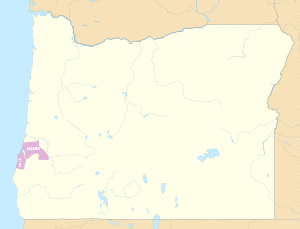| Coosan | |
|---|---|
| Kusan | |
| Ethnicity | Coos people |
| Geographic distribution | Oregon |
| Linguistic classification | Coast Oregon Penutian ?
|
| Subdivisions |
|
| Glottolog | coos1248 |
 Pre-contact distribution of Coosan languages in Oregon | |
The Coosan (also Coos or Kusan) language family consists of two languages spoken along the southern Oregon coast. Both languages are now extinct.
Classification
- Hanis †
- Miluk † (AKA Lower Coquille)
Melville Jacobs (1939) says that the languages are as close as Dutch and German. They share more than half of their vocabulary, though this is not always obvious, and grammatical differences cause the two languages to look quite different.
The origin of the name Coos is uncertain: one idea is that it is derived from a Hanis stem gus- meaning 'south' as in gusimídži·č 'southward'; another idea is that it is derived from a southwestern Oregon Athabaskan word ku·s meaning 'bay'.
In 1916 Edward Sapir suggested that the Coosan languages are part of a larger Oregon Penutian genetic grouping. This is currently being investigated. See Coast Oregon Penutian languages.
Phonology
Vowels
| SHORT | /i/ | /e/ | /a/ | /u/ | /ə/ |
| LONG | /i•/ | /e•/ | /a•/ | /u•/ | /-/ |
Diphthongs
| /ai/ | /a*/ |
| /e*/ | /o*/ |
Three Series of Stops
| Aspirated | /p/, /t/, /c/, /ĉ/, /k/, /kw/, /q/, /ʔ/ |
| Optionally Voiced | /b/, /d/, /ɜ/, /g/, /gw/, /G/ |
| Ejectives | /p'/, /t'/, /c'/, /k'/, /kw'/, /q'/ |
Consonants
| Labial | Coronal | Dorsal | Glottal | ||||||
|---|---|---|---|---|---|---|---|---|---|
| plain | lateral | affricate | plain | labial | |||||
| Occlusive | voice | b | d | d | g | gw | |||
| voiceless | p | t | ts | tc | k | kw | |||
| ejective | p' | t' | ts' | tc' | k' | kw' | |||
| Continuant | voice | m | n | l | j | ||||
| voiceless | s | ɬ | c | x | w | h | |||
Key
- Glottal Stops are represented by ʔ for subscript epsilon
- Ejectives raised by an apostrophe (p') can be substituted as exclamation points (p!)
- Length and gemination are shown by a dot (m•)
- ^ Mithum, Marianne (1999). The Languages of Native North America. The Pitt Building, Trumpington Street, Cambridge, United Kingdom: The Press Syndicate of the University of Cambridge. pp. 396–397.
- ^ Mithun, Marianne. The Languages of Native North America. Edited by R. M. W. Dixon and Alexandra Y. Aikhenvald, Cambridge University Press, 2001.
- Campbell, Lyle. (1997). American Indian languages: The Historical Linguistics of Native America. New York: Oxford University Press. ISBN 0-19-509427-1.
- Frachtenberg, Leo J. (1914). Lower Umpqua texts and notes on the Kusan dialects. Columbia University Contributions to Anthropology (Vol. 4, pp. 141–150). (Reprinted 1969, New York: AMS Press).
- Frachtenberg, Leo Joachim (1913). Coos texts. Columbia University Press. Retrieved 28 August 2012.
- Atlas of languages of intercultural communication in the Pacific, Asia, and the Americas
- Mithun, Marianne. (1999). The Languages of Native North America. Cambridge: Cambridge University Press. ISBN 0-521-23228-7 (hbk); ISBN 0-521-29875-X.
- Whereat, Don. (1992). (Personal communication in Mithun 1999).